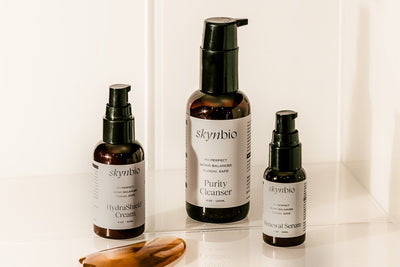Your skin is an ecosystem. When we protect that balance, skin looks and feels calmer, especially if you’re reactive, eczema-prone, or dealing with fungal overgrowths.
Understanding why we skip specific ingredient categories (and what we choose instead) helps you build a routine that supports your microbiome and moisture barrier without feeding overgrowths.
What we include (microbiome-safe, oil-free, barrier-loving)
We focus on gentle hydration, balance, and barrier support without occlusive oils or yeast-feeding lipids.
- Peptides — support visible repair and firmness without adding oil
- Ceramides — reinforce the lipid barrier to reduce water loss
- Panthenol (Pro-vitamin B5) — calms, hydrates, and supports barrier recovery
- Urea (low levels) — hydrates and softens while staying oil-free
- Niacinamide — helps balance tone/sebum and supports barrier function
- Humectants (glycerin, sodium hyaluronate) — deep hydration without occlusion
- Soothing botanicals (aloe, chamomile, cucumber) — comfort reactivity and visible redness
What we avoid (and why)
Many ingredients have valid uses, but for reactive skin and those prone to microbial overgrowths, these are common triggers, so we skip them to keep the ecosystem calm.
Fragrance & added perfume (including many essential oils)
- Why we avoid: frequent irritants that can overstimulate reactive skin
- Instead: low-odor formulas that prioritize skin-beneficial actives
Sulfate surfactants (e.g., SLS/SLES)
- Why we avoid: can strip the acid mantle, leading to tightness and rebound oiliness
- Instead: gentle, pH-balanced cleansing that removes debris without the “squeak”
Parabens (preservative class)
- Why we avoid: consumer preference and sensitivities
- Instead: modern, well-tolerated preservation that keeps formulas safe
Drying alcohols (e.g., Alcohol Denat. at high levels)
- Why we avoid: can compromise the barrier and increase redness/sensitivity
- Instead: humectants and barrier actives for fast-absorbing, oil-free hydration
Dyes & added fragrance allergens
- Why we avoid: unnecessary extras that can trigger irritation or contact reactions
- Instead: minimalist color-free, scent-light formulas
Silicones (occlusive film formers)
- Why we avoid: can trap buildup on sensitive, congestion-prone skin
- Instead: breathable, oil-free hydration with lightweight film formers
Polysorbates & certain ferments
- Why we avoid: some users prone to Malassezia overgrowth report flares; we err on the side of caution
- Instead: simple, microbiome-respectful emulsification
Oils/esters/fatty acids known to feed yeast
- Why we avoid: certain lipids can fuel Malassezia in susceptible skin, contributing to flares
- Instead: remain oil-free and use humectants + barrier actives for hydration without feeding overgrowths
Not every skin reacts the same way—and a single ingredient isn’t “bad” in every context. We design for the most sensitive, reactive users and those managing microbial overgrowths, so our line is intentionally conservative and oil-free.
How to use Skynbio for balanced results
- Cleanse: pH-balanced, sulfate-free cleansing that doesn’t strip
- Treat: targeted, microbiome-smart actives to support balance
- Hydrate: oil-free humectants + ceramides to reinforce resilience
Bottom line
Balanced skin starts with removing common triggers and strengthening the barrier without feeding microbial overgrowths. Our formulas are microbiome-safe, oil-free, and designed for sensitive, reactive skin.




